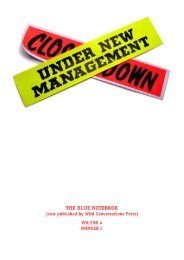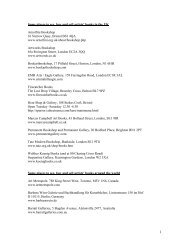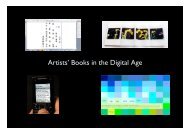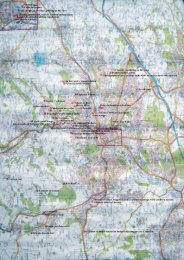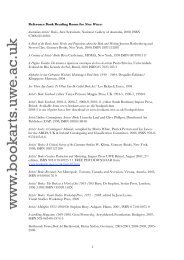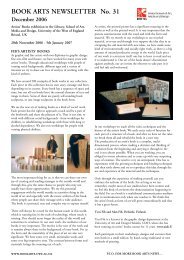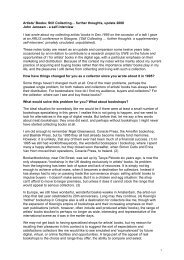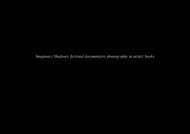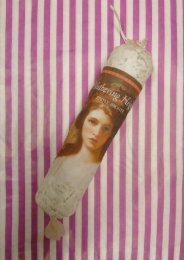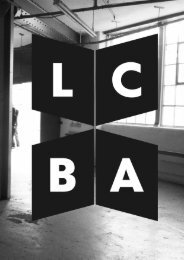Artist's Book Yearbook 2003-2005 - Book Arts - University of the ...
Artist's Book Yearbook 2003-2005 - Book Arts - University of the ...
Artist's Book Yearbook 2003-2005 - Book Arts - University of the ...
You also want an ePaper? Increase the reach of your titles
YUMPU automatically turns print PDFs into web optimized ePapers that Google loves.
An Essay About Reading An Artist’s <strong>Book</strong> About<br />
Reading<br />
Sarah Jacobs<br />
The essay and <strong>the</strong> artist's book described in it<br />
were conceived as being two parts <strong>of</strong> a single<br />
project and were made/written in <strong>the</strong> same<br />
space <strong>of</strong> time.<br />
You are looking at a smallish notebook, not too<br />
thick, say 100 pages or so. The black cover with<br />
manufacturer’s name at <strong>the</strong> back (Seawhite <strong>of</strong><br />
Brighton) gives nothing away but an intention -to<br />
be sober, discreet. Touch it. It is rough. Pick<br />
it up. You see immediately it has been divided<br />
in half. At <strong>the</strong> back, all <strong>the</strong> pages are clumped,<br />
bundled toge<strong>the</strong>r, tied by a narrow blue-grey<br />
ribbon. If you want to see what is inside <strong>the</strong><br />
bundle, you would need to take a decisive step.<br />
Who would start so bold? Not I. At <strong>the</strong> front,<br />
<strong>the</strong> fly leaf gives one author – Heinrich Von<br />
Kleist – but two translators, two publishers,<br />
two years <strong>of</strong> publication, and two titles – The<br />
Earthquake in Chile and The Chilean Earthquake. 1<br />
The words are handwritten, in ink and in<br />
pencil.<br />
Moving on, turning <strong>the</strong> pages, you see that<br />
each verso page is blank. Each recto page has a<br />
rectangle <strong>of</strong> paper, creamier in colour than <strong>the</strong><br />
paper <strong>of</strong> <strong>the</strong> notebook itself, pasted lightly on<br />
it. The pasted rectangles are printed but right<br />
away you can see something is happening –<br />
<strong>the</strong>re are gaps (not too many) and some words<br />
(ra<strong>the</strong>r few) are picked out by being printed<br />
more faintly than <strong>the</strong> main text. This is not a<br />
riddle. I will give <strong>the</strong> game away. This edition,<br />
this redaction, this notebook, this untitled<br />
artist's book, compares or picks out differences<br />
between <strong>the</strong> two translations, by Ronald Taylor<br />
and by David Constantine. It forms part <strong>of</strong> my<br />
translation studies, and its making was just<br />
about contemporaneous with <strong>the</strong> making <strong>of</strong><br />
‘The Unknown Masterpiece’ “Drawing <strong>Book</strong>” 2<br />
which is a multiple translation <strong>of</strong> <strong>the</strong> great<br />
short story by Honoré de Balzac.<br />
Having flipped through <strong>the</strong> front half, you turn<br />
to <strong>the</strong> beginning, and start to read. And – even<br />
though <strong>the</strong> initial words are missing – you can<br />
immediately locate yourself in time and in<br />
67<br />
space. It is 1647, in <strong>the</strong> Kingdom <strong>of</strong> Chile, in its<br />
capital, Santiago, and a young man is standing<br />
in a corner <strong>of</strong> a prison, preparing to hang<br />
himself.<br />
A year or two earlier in a grand house…and<br />
<strong>the</strong>n, again, here and secretly. In <strong>the</strong> garden <strong>of</strong><br />
a convent.<br />
What is this year 1647, and where is this Chile,<br />
this Santiago? Is it <strong>the</strong> first time you have visited<br />
<strong>the</strong> Kingdom and <strong>the</strong> story? Or <strong>the</strong> 3rd, or <strong>the</strong><br />
10th? And who are you anyway? The answer<br />
determines <strong>the</strong> time and space <strong>of</strong> your<br />
particular reading.<br />
Ostensibly, <strong>the</strong> place <strong>of</strong> <strong>the</strong> story is a city at <strong>the</strong><br />
bottom <strong>of</strong> <strong>the</strong> long thin country constituting<br />
most <strong>of</strong> <strong>the</strong> west coast <strong>of</strong> <strong>the</strong> lamb chop that<br />
was (when I was a girl) South, but which now<br />
forms part <strong>of</strong> Latin America. The Inca sites are<br />
far away. So far outside <strong>the</strong> story that it is only<br />
<strong>the</strong> most anachronistic reading that proposes<br />
<strong>the</strong>m as an absence or even a ghost. Peruvian<br />
dominion <strong>of</strong> <strong>the</strong> country has already ceased<br />
(1533) but its boundaries have not yet been<br />
agreed with Spain (1722). The city, familiarly,<br />
has houses, a convent, a prison, a mighty river,<br />
a Ca<strong>the</strong>dral with bells, law courts and a site for<br />
public executions. And, in <strong>the</strong> year <strong>of</strong> <strong>the</strong> story<br />
– at <strong>the</strong> very moment <strong>the</strong> story begins – <strong>the</strong> city<br />
is struck by a devastating earthquake. A matter<br />
<strong>of</strong> historical fact, or so I take on trust.<br />
For already <strong>the</strong> place is so far away, and <strong>the</strong><br />
time so remote from Kleist -- and <strong>the</strong> more so,<br />
from me -- that I abandon attempts at<br />
understanding this tale as an historical<br />
recreation <strong>of</strong> a far-<strong>of</strong>f continent in a chronicled<br />
and documented time. Did Kleist read eyewitness<br />
accounts <strong>of</strong> <strong>the</strong> earthquake? I care not.<br />
Was it an event which reverberated in world<br />
history? I doubt it. A thinly-veiled substitute for<br />
<strong>the</strong> earthquake which rocked Lisbon in 1755?<br />
Here we come closer. I remember that Voltaire<br />
published Candide in 1759, and a little<br />
research shows The Lisbon Disaster in 1756. So<br />
we are in Europe, in an age <strong>of</strong> philosophers,<br />
and two decades or so later, Kleist will be born.<br />
How long will it take you to discover that if you<br />
lift <strong>the</strong> lightly pasted rectangles, some <strong>of</strong> <strong>the</strong><br />
notebook pages have words handwritten on




